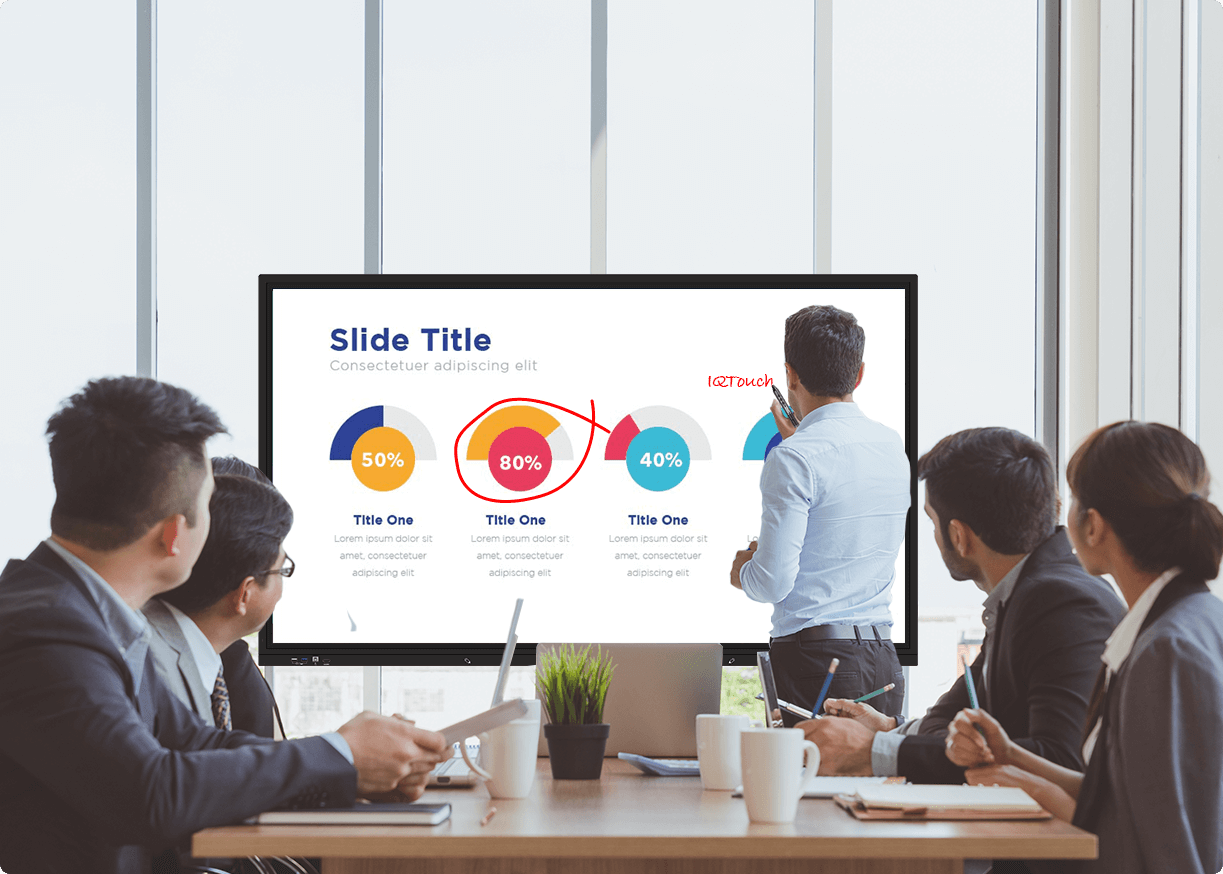Interactive flat panel displays (IFPDs) have transformed the landscape of education, business, and even healthcare. These advanced digital tools combine touch-screen technology with high-resolution displays, offering a versatile, user-friendly platform for presentations, collaboration, and interactive learning. From classrooms to boardrooms, interactive flat panel displays have established themselves as essential tools, enhancing engagement, fostering teamwork, and integrating seamlessly with digital content. This article explores the world of interactive flat panel displays, examining their features, benefits, applications, and the future trends driving their adoption.
What Are Interactive Flat Panel Displays?
Interactive flat panel displays are large, high-resolution touch screens designed to support a variety of collaborative and interactive functions. Unlike traditional projectors or whiteboards, IFPDs are equipped with advanced touch and gesture recognition capabilities, allowing multiple users to interact with the display simultaneously. Typically, these displays range in size from 55 to over 100 inches and are commonly found in classrooms, conference rooms, and public spaces.
At their core, interactive flat panel displays operate like giant tablets, integrating features such as:
- Multi-touch Technology: Supports multiple touchpoints, allowing several users to interact with the screen at once.
- High-resolution Displays: Most IFPDs offer 4K UHD resolution, providing crystal-clear visuals that enhance content visibility and detail.
- Integrated Operating Systems: Commonly powered by Android, Windows, or proprietary operating systems, which offer flexibility and compatibility with various software applications.
- Wireless Connectivity: IFPDs often support wireless connections for content sharing, screen mirroring, and integration with other digital devices, such as laptops, smartphones, and tablets.
Key Features of Interactive Flat Panel Displays
Interactive flat panel displays offer several features that set them apart from other digital display solutions. Let’s explore some of the essential features that make IFPDs a must-have tool for modern learning and collaborative environments:
1. Touch and Gesture Recognition
Interactive flat panels support multi-touch input, enabling users to control the display using natural gestures such as swiping, pinching, and zooming. Some models can detect up to 20 simultaneous touchpoints, allowing several users to interact with the screen simultaneously. This feature is especially useful in classrooms where students can collaborate on projects, or in business meetings where team members can engage with content directly.
2. 4K Ultra High Definition (UHD) Display
The majority of interactive flat panel displays come equipped with 4K UHD resolution, which provides sharp, vibrant visuals. The high resolution is ideal for displaying detailed images, videos, and presentations, ensuring that every detail is clearly visible to the audience. This level of clarity is particularly beneficial in environments where precision is crucial, such as design studios, engineering labs, and medical training facilities.
3. Integrated Digital Whiteboarding
IFPDs come with built-in digital whiteboarding software, allowing users to draw, annotate, and take notes directly on the display. Digital whiteboards offer a range of tools, including various pen colors, shapes, and erasers, which can replicate the experience of using a traditional whiteboard. These whiteboarding tools also allow users to save and share their notes, making it easier to retain information and collaborate with others.
4. Wireless Connectivity and Screen Mirroring
With wireless connectivity, users can easily share content from their devices to the interactive flat panel display without the need for cables. This feature supports both screen mirroring and content casting, which is useful in settings where multiple participants may want to present or share their screens. Screen mirroring is generally compatible with most smartphones, tablets, and laptops, making it convenient for quick, hassle-free sharing.
5. Integrated Cameras and Microphones
Many interactive flat panel displays come equipped with built-in cameras and microphones, facilitating video conferencing and remote collaboration. These built-in components eliminate the need for additional equipment, allowing users to conduct virtual meetings, training sessions, and classes directly from the display. High-quality audio and video ensure that all participants can communicate clearly, regardless of their location.
6. Access to Cloud-Based Resources
With built-in operating systems, IFPDs can access cloud-based resources and apps directly from the display. This allows users to integrate with popular cloud storage platforms, such as Google Drive, OneDrive, and Dropbox, providing easy access to files, presentations, and other digital content. Cloud integration also enables users to save and share content in real-time, which is particularly useful for collaborative projects and remote learning.
7. Interactive Software and Educational Tools
IFPDs often come preloaded with interactive software and educational tools, designed to support various learning and presentation needs. For educational environments, interactive displays may include subject-specific tools, games, and quizzes that engage students and reinforce learning. In business settings, software for brainstorming, project management, and data visualization can enhance presentations and foster creative problem-solving.
Benefits of Interactive Flat Panel Displays
The adoption of interactive flat panel displays is driven by their ability to deliver multiple benefits, making them invaluable in a variety of settings. Here are some of the primary advantages of using IFPDs:
1. Enhanced Collaboration and Engagement
Interactive flat panels foster a collaborative environment by allowing multiple users to interact with the display at once. This feature encourages teamwork, as users can contribute ideas, share files, and annotate content directly on the screen. The hands-on experience also increases engagement, making IFPDs ideal for interactive lessons, brainstorming sessions, and team meetings.
2. Improved Learning Outcomes
In educational settings, IFPDs provide an immersive learning experience that caters to different learning styles. Visual learners benefit from high-resolution images and videos, while kinesthetic learners can interact with content through touch. The ability to integrate multimedia content and digital tools also makes lessons more dynamic and engaging, helping students retain information and improve comprehension.
3. Ease of Use and Accessibility
Interactive flat panel displays are designed to be user-friendly, with intuitive touch interfaces and familiar operating systems. This ease of use makes it simple for both teachers and students to interact with content, even with minimal training. Additionally, IFPDs offer accessibility features such as text-to-speech, screen magnification, and customizable interfaces, making them more inclusive for users with disabilities.
4. Cost-Effectiveness and Reduced Maintenance
While the initial cost of an IFPD can be higher than that of a traditional projector or whiteboard, the long-term savings are significant. IFPDs have a longer lifespan, require less maintenance, and consume less energy than older technologies. Additionally, digital whiteboarding eliminates the need for markers, erasers, and paper, reducing ongoing costs and environmental impact.
5. Flexibility and Versatility
Interactive flat panel displays are versatile tools that can be adapted for various uses beyond traditional education and business applications. They are ideal for training, workshops, and creative sessions, providing a flexible platform that can be customized to meet the specific needs of different users. With access to a wide range of apps and cloud resources, IFPDs can support an array of tasks, from video conferencing to interactive presentations.
6. Remote Collaboration Capabilities
As remote work and learning become increasingly common, the need for tools that support virtual collaboration is greater than ever. IFPDs offer built-in video conferencing tools, screen sharing, and remote access capabilities, making it easy for users to collaborate with others, regardless of their physical location. This feature is invaluable for businesses with remote teams, as well as educational institutions offering virtual or hybrid learning options.
Applications of Interactive Flat Panel Displays
The versatility of interactive flat panel displays allows them to be used across a wide range of industries and settings. Here are some of the primary applications of IFPDs:
1. Education and Training
In K-12 and higher education settings, interactive flat panel displays are used to create dynamic, interactive classrooms. Teachers can display lessons, play educational videos, and encourage student participation through hands-on activities. IFPDs also support distance learning, allowing students to join virtual classes and interact with content in real-time. In corporate training environments, IFPDs facilitate workshops and skill-building exercises by providing a collaborative platform for interactive learning.
2. Corporate and Business
In the business world, interactive flat panel displays are essential tools for presentations, team meetings, and brainstorming sessions. With video conferencing capabilities, IFPDs enable seamless communication between remote teams, making it easier to collaborate on projects and share ideas. Additionally, IFPDs support data visualization and project management, helping teams stay organized and make informed decisions.
3. Healthcare
Healthcare organizations use interactive flat panel displays for patient education, staff training, and collaborative planning. Doctors and medical staff can use IFPDs to display medical images, explain treatment options, and engage patients in their care. IFPDs also support telemedicine, allowing healthcare providers to conduct virtual consultations and collaborate with specialists remotely.
4. Retail and Hospitality
In the retail and hospitality industries, IFPDs are used for digital signage, customer engagement, and staff training. Retail stores can display product information, promotions, and interactive catalogs, enhancing the shopping experience. In hotels, IFPDs can provide guests with information about amenities, local attractions, and events, while also supporting internal operations such as employee training and guest services.
5. Government and Public Sector
Government agencies and public sector organizations use interactive flat panel displays for training sessions, public meetings, and emergency response coordination. IFPDs provide a platform for displaying maps, annotating documents, and collaborating with remote teams, making them valuable tools for planning and communication in various public service roles.
Choosing the Right Interactive Flat Panel Display
When selecting an interactive flat panel display, it’s important to consider factors such as size, resolution, operating system, and connectivity. Here are some key considerations to keep in mind:
1. Size and Resolution
The size of the IFPD should match the intended audience and space. Larger displays (over 75 inches) are ideal for large conference rooms and classrooms, while smaller displays (55-65 inches) are suitable for huddle rooms and small meeting spaces. Resolution is also critical; a 4K UHD display is recommended for detailed visuals and clarity.
2. Operating System and Compatibility
Interactive flat panel displays may run on Android, Windows, or proprietary operating systems. Choose a panel that is compatible with the devices and software you intend to use. Windows-based panels often offer better compatibility with Microsoft Office and other Windows applications, while Android-based panels provide access to a wide range of apps through the Google Play Store.
3. Connectivity Options
Ensure that the IFPD has sufficient connectivity options to meet your needs. Look for HDMI, USB, and wireless connectivity options for easy integration with various devices. Some displays also support NFC and Bluetooth, which can be useful for certain applications, such as mobile device pairing and wireless sharing.
4. Touch Technology and Responsiveness
Different interactive flat panel displays use different touch technologies, such as infrared, capacitive, or optical touch. Capacitive touch provides a more responsive and accurate experience, but it can be more expensive. Consider the type of interactions you expect to use and choose a panel with touch technology that matches your requirements.
5. Built-in Features and Software
Evaluate the built-in features and software that come with the IFPD. Look for features like interactive whiteboarding, screen mirroring, and annotation tools. Some panels also come with pre-installed educational or collaboration apps, which can be a significant advantage depending on your use case.
The Future of Interactive Flat Panel Displays
As technology continues to evolve, interactive flat panel displays are likely to become even more advanced and widely used. Here are some trends shaping the future of IFPDs:
1. Artificial Intelligence (AI) and Machine Learning
Future IFPDs are expected to incorporate AI and machine learning capabilities, enabling more intuitive interactions and personalized experiences. For example, AI-powered displays could analyze user behavior to suggest relevant content or automatically adapt to different teaching or presentation styles.
2. Enhanced Connectivity and IoT Integration
With the growth of the Internet of Things (IoT), IFPDs are likely to integrate more seamlessly with other smart devices. This could enable new functionalities, such as controlling smart lighting, adjusting room temperature, and connecting with wearable devices for real-time data sharing.
3. Augmented Reality (AR) and Virtual Reality (VR)
AR and VR technologies are expected to be integrated with IFPDs, offering new ways to visualize and interact with content. For example, students could explore 3D models of historical artifacts or biological structures, while businesses could use AR/VR for immersive training experiences.
4. Improved Accessibility and Inclusivity
Future interactive flat panel displays are expected to offer even more features for accessibility and inclusivity, such as advanced voice recognition, real-time translation, and customizable interfaces for individuals with disabilities. This will make IFPDs more accessible to a broader range of users and promote inclusivity in learning and collaboration environments.
Conclusion
Interactive flat panel displays have revolutionized the way we teach, learn, and collaborate. With their wide range of features and applications, IFPDs offer a versatile platform that enhances engagement, improves learning outcomes, and facilitates seamless collaboration. As technology advances, interactive flat panel displays are poised to become even more integral to modern education, business, and beyond, driving innovation and transforming the way we interact with digital content. Whether you’re an educator, business professional, or technology enthusiast, the interactive flat panel display is a powerful tool that promises to make communication and collaboration more effective, engaging, and inclusive.












